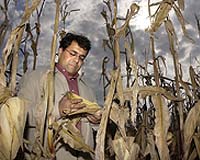 |
Raleigh, N.C. (UPI) Aug 31, 2010 Human impact on a shellfish consumed in the Pacific for thousands of years may have caused the species to actually increase in size, U.S. researchers say. Scientists at North Carolina State University, in a counterintuitive finding, say the average size of the humped conch, a food source in the Pacific islands for 3,000 years, has increased in spite of -- or even possibly because of -- increased human activity in the area, a university release said Tuesday. "What we've found indicates that human activity does not necessarily mean that there is going to be a negative impact on a species -- even a species that people relied on as a major food source," Scott Fitzpatrick, associate professor of sociology and anthropology at NC State, said. "The trends we see in the archaeological record in regard to animal remains are not always what one would expect." Researchers expected the size of the conchs to decrease over time, based on the conventional wisdom that an expanding human population would result in the conchs being harvested before they could achieve their maximum size. Instead, they say, the average size of the conchs actually increased in conjunction with a growing human population. Fitzpatrick believes the size increase is likely related to an increase in nutrients in the conch's waters, a result of increased agriculture and other human activities. "In the big picture," Fitzpatrick says, "this study tells us to focus on the physical evidence and beware of conventional wisdom."
Share This Article With Planet Earth
Related Links Farming Today - Suppliers and Technology
 Growing Drought-Tolerant Crops Inching Forward
Growing Drought-Tolerant Crops Inching ForwardMilwaukee WI (SPX) Aug 31, 2010 A collaborative team of scientists led by researchers at The Medical College of Wisconsin, in Milwaukee, has used the tools of structural biology to understand how a synthetic chemical mimics abscisic acid (ABA), a key stress hormone that helps plants cope with adverse environmental conditions such as drought. The results are published online in Nature Structural and Molecular Biology in a ... read more |
|
| The content herein, unless otherwise known to be public domain, are Copyright 1995-2010 - SpaceDaily. AFP and UPI Wire Stories are copyright Agence France-Presse and United Press International. ESA Portal Reports are copyright European Space Agency. All NASA sourced material is public domain. Additional copyrights may apply in whole or part to other bona fide parties. Advertising does not imply endorsement,agreement or approval of any opinions, statements or information provided by SpaceDaily on any Web page published or hosted by SpaceDaily. Privacy Statement |